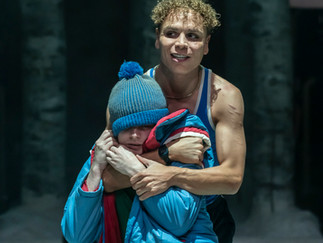Let The Right One In
- Peter Ruddick

- Oct 28, 2022
- 3 min read
John Ajvide Lindqvist, stage adaptation by Jack Thorne
Marla Rubin Productions
Royal Exchange Theatre, Manchester
October 22-November 29; 2hr 20min


Given the power of theatre, it’s surprising how few stage productions have embraced horror. Even those that have succeeded - The Woman in Black, Ghost Stories for example - rely on jump scares over emotion.
Let The Right One In is a shining example of what can be achieved. Unsettling, beautiful, thought-provoking, perfectly staged in a complex space. It’s faultless.
Audiences familiar with the Swedish novel and movie (don’t mention the English-language remake) will need no introduction. But there’s zero requirement to have any previous knowledge. Within a few minutes, theatregoers know all they need to know to immerse themselves in this world, thanks to a set of clever interlocking scenes and vignettes.
Oskar endures a lonely existence: moving between a school in which he’s bullied mercilessly, the local sweet shop and an empty playground outside the small home he shares with his single mum. Empty, that is, until Eli appears.
A friendship is clearly possible between the two outsiders who have ended up neighbours. But with a vicious murderer on the loose, their relationship is going to be far from simple.
The plot is gripping. The themes of otherness and bullying are universal. At its heart is a touching love story. But staging it in the Royal Exchange cannot have been easy. Under the direction of Bryony Shanahan though, cast and creatives don't put a foot wrong.
As Oskar and Eli, Pete MacHale and Rhian Blundell are utterly believable. Their truthful performances lead the production, but they’re supported by a brilliant ensemble, including members of the theatre's Young Company.
After a fantastic performance in Liverpool Everyman’s triumphant Cherry Valentine, Stefan Race is back on top form as Jonny. Disturbing, broken and never out of character.
Several of the cast play multiple roles. Special mention to Darren Kuppan, who fills each of his with depth of soul.
The design, from Amelia Jane Hankin is inventive and unfussy, perfectly setting the tone. Snow-covered birch trees and a climbing frame of twisting metal give us a sense of being on the border between urban and rural.
Rapid, perfectly executed scene changes carry the audience from place to place. So much is achieved with so little. A few towels and some boxes, combined with Joshua Pharo’s lighting design, is enough to show we’re in a gym changing room, where the mood is ominous.
Every inch of the auditorium is used and everything comes together in a stunningly-realised swimming pool scene, which feels almost unwatchable (in a good way) due to the oppressive atmosphere.
Like all the best scary movies, sound is key. Pete Malkin’s design and composition are not just horrifying though; Morse code taps and slaps combine with echoes and music to create something hauntingly beautiful.
In fact, despite all the hard work, nothing overshadows the bittersweet love story.
Ambiguity is embraced. A Rubik cube might suggest we’re in the 1980s, but time and place are never forced. Multiple accents, British and foreign, are used, pushing the attention away from "where" to "why". Everything exists only to serve character development.
We learn all we need to about Oskar by his clambering and ungainly ascent up the climbing frame. That’s surely thanks to movement direction from Yandass Ndlovu, which often looks like dance choreography.
Naturally, a good horror production also needs blood and scares. Rest assured both are present in abundance.
It must be said that all of this success is possible thanks to a clever adaptation from Jack Thorne. The cast feels so at home with his simple, on-point dialogue they’re able to speak over each other in a way that seems natural.
It’s possible that horror is rarely tackled on stage because it’s difficult to get right. If so, theatre makers should join audiences in watching this show, to learn what is possible.
More info and tickets here











